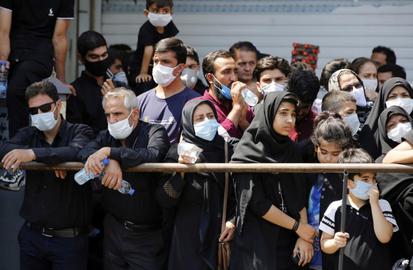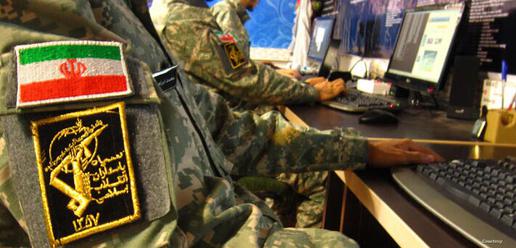Iranian pilgrims clashed with Iraqi border authorities during the third week of September after Iraq banned travel to the country to mark the Shia holiday of Arba’een. This year the holiday, the 40th day of the martyrdom of Imam Hossein on the Islamic lunar calendar, falls on October 8. Traditionally, thousands of Shia pilgrims travel to Karbala in Iraq to pray at his shrine, but this year, in an effort to stop the spread of coronavirus, the Iraqi government banned entry by foreign pilgrims. Iran’s Arba’een Organizing Headquarters also announced the cancelation of ceremonies in Iraq, but nevertheless, a number of pilgrims began traveling toward Iraqi borders.
After a period of silence on the matter, Supreme Leader Ayatollah Khamenei addressed pilgrims himself on September 21. “If the headquarters says no to Arba’een marches, it means no,” he said. “Pilgrims must not go to the border and pay their respects.”
Officials Blame Sanctions for Flu Vaccine Shortage
Iran does not currently produce a flu vaccine, so the fact that Iran’s medical community has failed to import the needed levels of vaccine despite repeated promises has sent waves of panic across the country. The anticipated epidemic coupled with the ongoing coronavirus crisis could mean a spike in fatalities and a dangerous strain on Iran’s health facilities.
Officials had initially promised that between 10 and 12 million doses of the vaccine would be imported from European countries, but the promise is yet to be realized. Instead, 22 million euros allocated for the purchase of the vaccine is currently sitting in a bank in Turkey, blocked as a result of sanctions against the Islamic Republic.
The president of Iran’s Food and Drug Administration informed the public that Iran secured the currency “by going through a lot of trouble,” and agreements have now been signed. But, said Mohammad Reza Shanehsaz, the “cruel sanctions” have made the transfer of funds extremely difficult. “When they say that medicine, vaccines and medical equipment are not under sanctions they are lying,” said Shanehsaz. “What does it mean when you prevent a bank from transferring funds? These mischiefs continue but we are trying to get these items as soon as possible.”
Nevertheless, Shanehsaz claimed that the necessary volume of vaccine for high-risk groups such as the elderly and pregnant women had already been imported. He said that, starting on September 22, the vaccine will be distributed by pharmacies through the Tracing, Tracking and Authentication Control (TTAC) system using patients’ or customers’ National ID Codes.
According to Dr. Sima Sadat Lari, the health ministry’s spokeswoman, Iran currently had 1.5 million doses of flu vaccine for high-risk groups and the ministry is in the process of distributing them. “The priority of vaccination is with rural pregnant women,” she said.
The price of the flu vaccine is another issue about which the government has not been clear. Mohammad Reza Shanehsaz said that Iran purchased the vaccine at 4,200 tomans per dollar, lower than what neighboring countries had paid. When asked what it would cost the consumer, he said simply: “Prices are not going to be very high.”
But Ali Fatemi, vice president of the Iran Pharmacists Association, was able to give a more accurate answer. “The price of this vaccine to be offered to the public through private pharmacies has been estimated to be around 42,000 tomans ($10) but if it is imported at free-market currency prices it could cost more than 200,000 tomans ($48),” he said. He added that it was not possible to be exact.
Fatemi also said the vaccine would be made available for free to high-risk groups, but then emphasized: “Unfortunately, it seems as though people are not going to receive the expected doses of vaccine.”
On September 14, Ali Hemmati, president of Iran’s Red Crescent Society, had announced that Iran was paying between 5.9 and 7 euros for each dose of vaccine.
Sadat Lari reported on September 21 that Iran has preordered a coronavirus vaccine, following a statement by Health Minister Saeed Namaki, who said on September 19 that Iran will import 20 million doses of a coronavirus vaccine from India.
According to Sadat Lari, Iran has joined an alliance of 180 countries going by the name COVAX, a group that also includes 18 organizations and companies actively working toward the creation and production of a coronavirus vaccine. “The sale of the vaccine is contingent upon prepayment of 15 percent of the price by the country that wants to buy them,” she said. “And if they do not succeed [in making a vaccine] this fund is not returned. In the last meeting of the National Coronavirus Taskforce the payment of this 15 percent was approved and I believe it was paid on September 10.”
Provinces Round-up
Reporting that Khuzestan province faces a shortage of hospital beds, Dr. Mohammad Alavi, vice president of Khuzestan Jondishapur University of Medical Sciences, said: “No health system can have enough beds for all potential patients and, therefore, if the health system is overwhelmed by the number of patients, there will be difficulty in finding a bed.”
And Dr. Farhad Abolnejadian, president of the same university, pointed out that Khuzestan is in a red state of alert and reported that out of every 100,000 people in the province between 1.2 and 1.3 individuals are currently hospitalized.
In Zanjan province more than 50 percent of ICU patients are in a critical condition. “Currently 338 coronavirus patients are hospitalized across the province,” said Dr. Parviz Ghezelbash, president of Zanjan University of Medical Sciences. “Of this number 76 are in ICUs and 50 percent of them are in a critical condition.”
Dr. Ghezelbash said that rate of fatalities in Zanjan hospitals had fallen but predicted that in two or three weeks, with the resurgence of the epidemic, the number of fatalities will rise again.
On September 20 it was reported that 13 students had died from Covid-19 in the province of Kermanshah. However, Ebrahim Shakiba, vice president of Kermanshah University of Medical Sciences, denied the report, though he said that since the coronavirus outbreak in the province eight children had contracted the virus and died from it in the province, and all of them were under five years of age. “This number has nothing to do with the reopening of schools because all these children were under five and they were not at school,” he said.
In her daily briefing for September 21, the health ministry’s spokeswoman Dr. Sima Sadat Lari announced the official coronavirus statistics for the last 24 hours:
Dr. Lari also reported that of Iran’s 31 provinces, currently 24 provinces are in a red state of alert and five provinces are in an orange state.
This is part of IranWire's coronavirus chronology. Read the full chronology
visit the accountability section
In this section of Iran Wire, you can contact the officials and launch your campaign for various problems



























comments